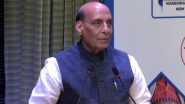Washington, Nov 29 (AP) Donald Trump loved to use tariffs on foreign goods during his first presidency. But their impact was barely noticeable in the overall economy, even if their aftershocks were clear in specific industries.
The data show they never fully delivered on his promised factory jobs. Nor did they provoke the avalanche of inflation that critics feared.
Also Read | Israel Launches First Airstrike on Lebanon Since Ceasefire, Accusing Hezbollah of Breaching Truce.
This time, though, his tariff threats might be different.
The president-elect is talking about going much bigger — on a potential scale that creates more uncertainty about whether he'll do what he says and what the consequences could be.
“There's going to be a lot more tariffs, I mean, he's pretty clear,” said Michael Stumo, the CEO of Coalition for a Prosperous America, a group that has supported import taxes to help domestic manufacturing.
The president-elect posted on social media Monday that on his first day in office he would impose 25 per cent tariffs on all goods imported from Mexico and Canada until those countries satisfactorily stop illegal immigration and the flow of illegal drugs such as fentanyl into the United States.
Those tariffs could essentially blow up the North American trade pact that Trump's team negotiated during his initial term. But on Wednesday, Trump posted on social media that he had spoken with Mexican President Claudia Sheinbaum and she had agreed to stop unauthorised migration across the border into the United States.
Trump also posted on Monday that Chinese imports would face additional tariffs of 10 per cent until Beijing cracks down on the production of materials used in making fentanyl.
Democrats and business groups warn of risks from Trump's tariff threats
Business groups were quick to warn about rapidly escalating inflation. House Democrats put together legislation to strip a president's ability to unilaterally apply tariffs this drastic, warning that they would likely lead to higher prices for autos, shoes, housing and groceries.
Sheinbaum initially said Wednesday that her administration is already working up a list of possible retaliatory tariffs “if the situation comes to that.” Similarly, the Canadian government has also started to explore retaliatory tariffs if Trump takes action.
House Democrats on Tuesday introduced a bill that would require congressional approval for a president to impose tariffs due to claims of a national emergency, a largely symbolic action given Republicans' coming control of both the House and Senate.
"This legislation would enable Congress to limit this sweeping emergency authority and put in place the necessary Congressional oversight before any president – Democrat or Republican – could indiscriminately raise costs on the American people through tariffs,” said Rep. Suzan DelBene, D-Wash.
But for Trump, tariffs are now a tested tool that seems less politically controversial even if the mandate he received in November's election largely involved restraining inflation.
The tariffs he imposed on China in his first term were continued by President Joe Biden, a Democrat who even expanded tariffs and restrictions on the world's second largest economy. Biden administration officials looked at removing Trump's tariffs in order to bring down inflationary pressures, only to find they were unlikely to help significantly.
Tariffs were “so new and unique that it freaked everybody out in 2017,” said Stumo, but they are now seen as part of the policy toolkit by the United States and other countries.
Trump's first term tariffs had a modest impact on economy
Trump imposed tariffs on solar panels and washing machines at the start of 2018, moves that might have pushed up prices in those sectors even though they also overlapped with plans to open washing machine plants in Tennessee and South Carolina.
His administration also levied tariffs on steel and aluminum, including against allies. He then increased tariffs on China, leading to a trade conflict and a limited 2020 agreement that failed to produce the promised Chinese purchases of US goods.
Still, the dispute changed relations with China as more US companies looked for alternative suppliers in other countries. Economic research also found the United States may have sacrificed some of its “soft power” as the Chinese population began to watch fewer American movies.
The Federal Reserve kept inflation roughly on target, but factory construction spending never jumped in a way that suggested a lasting gain in manufacturing jobs. Separate economic research found the tariff war with China did nothing economically for the communities hurt by offshoring, but it did help Trump and Republicans in those communities politically.
When Trump first became president in 2017, the federal government collected $34.6 billion in customs, duties and fees. That sum more than doubled under Trump to $70.8 billion in 2019, according to Office of Management and Budget records.
While that sum might seem meaningful, it was relatively small compared with the overall economy. America's gross domestic product is now $29.3 trillion, according to the Bureau of Economic Analysis. The total tariffs collected in the United States would equal less than 0.3 per cent of GDP.
Trump wants much more far-reaching tariffs going forward
The new tariffs being floated by Trump now are dramatically larger and there could be far more significant impacts.
If Mexico, Canada, and China faced the additional tariffs proposed by Trump on all goods imported to the United States, that could be roughly equal to $266 billion in tax collections, a number that does not assume any disruptions in trade or retaliatory moves by other countries. The cost of those taxes would likely be borne by US families, importers and domestic and foreign companies in the form of higher prices or lower profits. (AP)
(This is an unedited and auto-generated story from Syndicated News feed, LatestLY Staff may not have modified or edited the content body)













 Quickly
Quickly

















